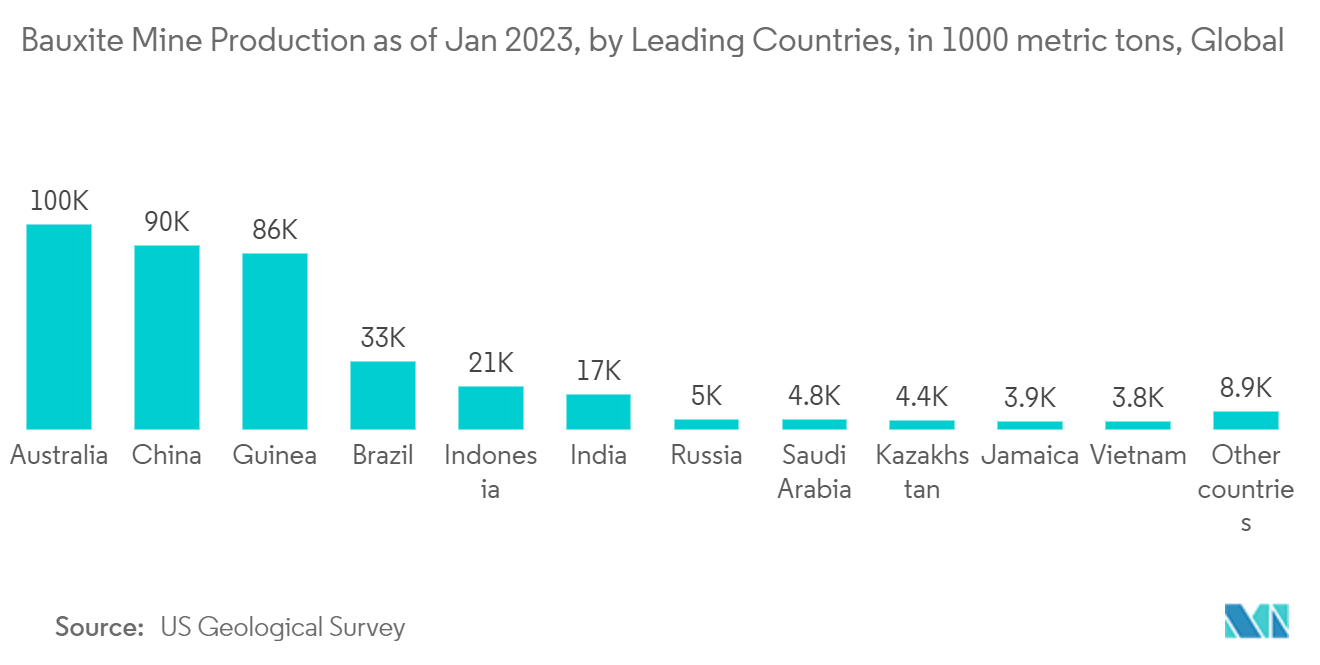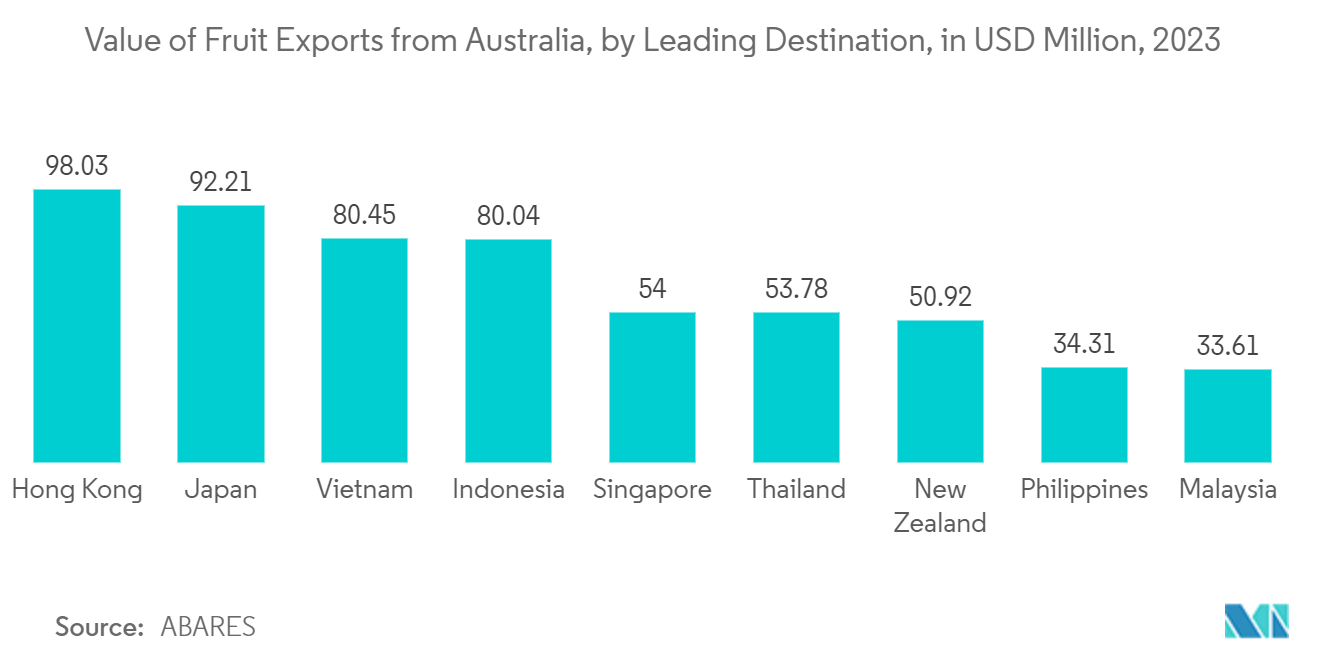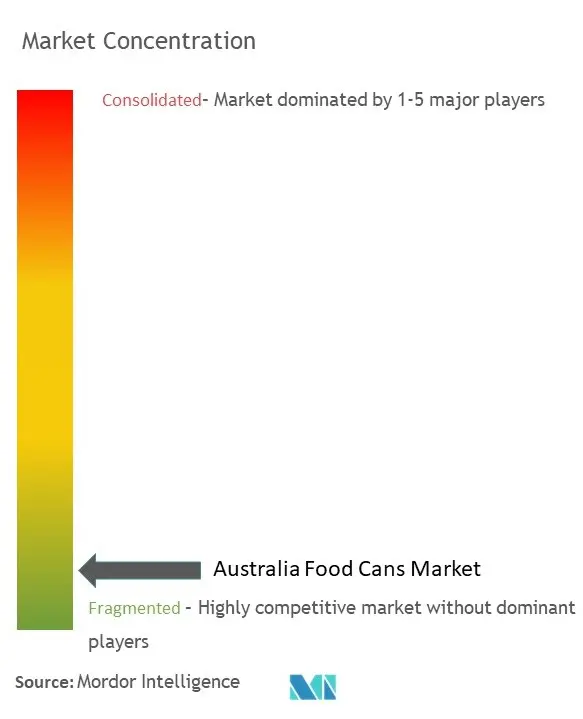Australia Food Cans Market Size

| Study Period | 2024 - 2029 |
| Base Year For Estimation | 2023 |
| Market Size (2024) | USD 389.90 Million |
| Market Size (2029) | USD 454 Million |
| CAGR (2024 - 2029) | 3.09 % |
| Market Concentration | Low |
Major Players
*Disclaimer: Major Players sorted in no particular order |
Australia Food Cans Market Analysis
The Australia Food Cans Market size is estimated at USD 389.90 million in 2024, and is expected to reach USD 454 million by 2029, growing at a CAGR of 3.09% during the forecast period (2024-2029).
An increased focus on convenience and easy consumption has backed Australia's canned food market. Being readily available year-round makes canned food very convenient for Australian consumers. The innovations in packaging techniques to improve products' shelf life and retail infrastructure might also have pushed the top line.
- According to the Australian Government Report, Australians waste about 7.6 million tons of food in the food supply chain every year, which is 312 kg of food waste per person and about USD 2,500 worth of food waste per household each year. As canned food can ensure a longer shelf-life of the product, this might be a preferred choice for food packaging to reduce food waste in Australia.
- The Canned Food Information Service Inc. (CFIS) promoted Australian food packaged in steel cans. It focused on generating more purchases by ensuring that Australian canned food remains a common ingredient in meals rather than an occasional or standby food. These actions also influenced canning companies to become more responsible for their choice of future packaging direction to create a climate of greater confidence in the future of metal food.
- Growing environmental concerns worldwide have increased awareness about the type of packaging materials utilized. High energy consumption of packaging manufacturing is one of the factors pushing recycling.
- Diminished natural reserves, global warming, and the impact of plastics on the environment are the key trends influencing consumer demand. Recycling aluminum can significantly reduce operating costs. For example, using recycled aluminum to produce new aluminum can result in 95% energy savings.
- However, the packaging of metal cans faces much competition from other packaging solutions as alternatives such as plastic, paper, or glass packaging solutions are available widely. Plastic packaging continues to be the main competitor of metal packaging. The food and beverage industry, which is the primary user of metal cans, started adopting recyclable plastic packaging solutions. Plastic cans are transparent, which helps brands to show their food's quality. Moreover, incremental enhancements in plastic packaging are posing a threat to the market.
Australia Food Cans Market Trends
Steel/Tin Material Type Segment is Expected to Hold Significant Market Share
- Aluminum is extensively used in food contact materials. The aluminum material possesses unique barrier and physical properties and is therefore used for food packaging. Even in its thinnest form, aluminum protects food contents against the quality-reducing effects of light, oxygen, micro-organisms, moisture, and unwanted aromas. Cans made from aluminum are lightweight, stackable, and strong, enabling companies to package and transport more food using less material.
- Companies in the market studied are focusing on enhancing the sustainability aspects of the packaging material. Aluminum stands out among the packaging materials from a sustainability perspective as it can be recycled unlimited times. While aluminum cans are trendy, they significantly increase energy efficiency as they chill faster and stay cool for extended periods. According to a new study by the Aluminum Association in November 2023, aluminum cans have a consistently lower carbon impact than glass bottles and plastic (PET) containers. Further, the combined greenhouse gas emission linked to the transportation of aluminum cans is lower than glass or plastic bottles. Cans made from aluminum are also tamper-proof and prevent manufacturers, retailers, and consumers from losing cans due to breakage.
- Furthermore, vendors, retailers, and consumers prefer aluminum cans over other products due to awareness of environmental impact. Aluminum does not degrade during recycling since its atomic structure is not altered during melting. Aluminum recycling is both economically and environmentally effective, as it consumes much less energy during the recycling process than it does to mine, extract, and smelt aluminum ore. Approximately 70% of all aluminum cans produced in Australia are collected for recycling (Source - Aluminium Can Group, George Unger and Associates & Kaal Australia).
- Producing aluminum requires the mining of bauxite. According to the latest data by Australian Aluminum Council Ltd, Australia is the world’s largest producer of bauxite, with five large mines supplying around 30% of global production. Further, as per the US Geological Survey in January 2023, Australian bauxite production was 100 million metric tonnes (Mt). Of these, 39.8 million Mt of bauxite was exported, and the remainder was converted to Australian alumina. Australian primary aluminum metal production was 1.51 million tons in 2022, making it the world’s sixth-largest producer.
- Thus, Australia has tremendous opportunities for manufacturers of aluminum food cans that can produce high-quality aluminum cans with an efficient supply chain by continuously available raw materials. Further, the country may significantly boost its economy by allowing more FDI in the aluminum can manufacturing sector.

Fruits and Vegetables Application Segment is Expected to Hold Significant Market Share
- Fruit and vegetable prices and availability in Australia have been affected by the recent weather. Rain has caused the price of green vegetables to skyrocket. Canned fruits and vegetables are convenient because they are available throughout the year regardless of the season and can be stored for months or years without refrigeration. Canned fruits, like canned vegetables, have a long shelf life, making them suitable for stocking up.
- The fruit production of the types covered by the Australian Canned Fruit Industry Council (Apples, Apricots, Peaches, Pears, and Plums) occurs between December and May. It is processed at 30,000-35,000 tons annually. The Australian canned fruit and vegetable industry comprises over 110 fruit-growing enterprises and one processor. The canned fruit business operates mainly in Victoria’s Goulburn and Murray Valleys, processing Australian apples, apples, Apaches, peaches, and plums in Shepparton.
- Some fruits and vegetables are currently much more affordable in cans, even though they are usually grown and processed in multiple countries before being sold in Australia. Fruit and vegetable prices have risen significantly for shoppers, although canned produce prices have remained relatively low in Australia.
- According to the University of Southern Queensland Associate Professor, farmers' growing costs have risen between 30% and 60% over the last five years, mainly due to higher fuel prices and more stringent industrial relations regulations. On the other hand, canned produce was usually produced cheaply overseas in large quantities by big corporations. The profession also stated that canned food has a longer shelf life, which makes it easier to make and store in large quantities without the risk of spoilage.
- The major factor anticipated to create growth opportunities is the advancements in canning technology. Increased research and development spending will be accompanied by the production of healthier fruits and vegetables, improved Nutri-score labels, and a more comprehensive range of convenience products. The market is expected to grow as a canned fruits and vegetables distribution network, including offline and online retailers specializing in niche or specialty food markets such as vegan and organic.
- According to ABARES, in FY 2023, the value of fruit exports from Australia to China totaled AUD 345 million (USD 225.07 million). China was the leading export destination for Australian fruit products, accounting for almost 25% of the total value of fruit exports.

Australia Food Cans Industry Overview
The Australian food cans market is highly fragmented, with the presence of major players like CCL Industries Inc., Primepac, Visy Group, Sonoco Products Company, and Jamestrong Packaging. Players in the market studied are adopting strategies such as partnerships and acquisitions to enhance their product offerings and gain sustainable competitive advantage.
- In November 2023 - Visy Group installed advanced equipment to manufacture an additional 100 million food cans locally in its Victoria plant to accelerate local production, optimizing efficiency.
- In July 2023 - the University of New South Wales (UNSW) SMaRT Centre and Jamestrong collaborated to advance aluminum manufacturing and recycling in Australia. The joint project is being funded by Jamestrong and UNSW as part of the government’s Trailblazer for Recycling and Clean Energy (TRaCE) program.
Australia Food Cans Market Leaders
-
CCL Industries Inc.
-
Primepac
-
Visy Group
-
Sonoco Products Company
-
Jamestrong Packaging
*Disclaimer: Major Players sorted in no particular order

Australia Food Cans Market News
- January 2024 - According to the news published by ABS Radio Brisbane, vegetables in the Australian market are getting more expensive than canned foods. As vegetables across the country experience a price increase, the affordability of canned foods remains a contrasting and attractive option for consumers. In the face of rising vegetable costs, the affordability of canned products provides a compelling incentive for consumers, emphasizing the resilience and market expansion of the Australian food can industry.
- October 2023 - TasFoods expanded its foothold in the pet food category in Australia with the launch of its brand Isle & Sky. TasFoods' new pet food line – created by the company's Nichols poultry business unit – features three new premium cat and dog chicken products pouches, including chicken necks, chicken neck bites, and chicken wing tips. TasFoods partnered with the country's leading specialist pet-products retailer, Petbarn, to launch the new range in more than 200 stores in Australia.
Australia Food Cans Market Report - Table of Contents
1. INTRODUCTION
- 1.1 Study Assumptions and Market Definition
- 1.2 Scope of the Study
2. RESEARCH METHODOLOGY
3. EXECUTIVE SUMMARY
4. MARKET INSIGHTS
- 4.1 Market Overview
- 4.2 Industry Attractiveness - Porter's Five Forces Analysis
- 4.3 Assessment of the Impact of the Ongoing Geopolitical Developments on the Food Cans Market in Australia
- 4.4 Analysis of the Food Industry in Australia - Key Trends Covered Include Current Consumption Trends, Local Production, and Key Trading Countries
- 4.5 Analysis of the Overall Metal Cans Market - Covering Key Application Areas Such as Beverage Cans, Aerosol Cans, etc.
5. MARKET DYNAMICS
-
5.1 Market Drivers
- 5.1.1 Constant Initiatives of Recyclability and Recovery Rates of Metal Cans in Australia
-
5.2 Market Challenges
- 5.2.1 Presence of Alternate Packaging Solutions in Australia
- 5.2.2 Growing Dependency on Fresh Fruits and Vegetables
6. MARKET SEGMENTATION
-
6.1 By Material Type
- 6.1.1 Steel/Tin
- 6.1.2 Aluminum
-
6.2 By Can Type
- 6.2.1 2-piece
- 6.2.2 3-piece
-
6.3 By Application
- 6.3.1 Fish and Seafood
- 6.3.2 Fruits and Vegetables
- 6.3.3 Processed Food
- 6.3.4 Pet Food - Includes Dog Food
- 6.3.5 Other Applications
7. COMPETITIVE LANDSCAPE
-
7.1 Company Profiles*
- 7.1.1 CCL Industries Inc.
- 7.1.2 PrimePac
- 7.1.3 Visy Group
- 7.1.4 Sonoco Company
- 7.1.5 Jamestrong Packaging
- 7.1.6 Perennial Packaging
- 7.1.7 Morris McMahon & Co Pvt. Ltd
- 7.1.8 NCI Packaging (National Can Industries Ltd)
- 7.1.9 Irwin Packaging Holdings Pty Ltd
8. INVESTMENT ANALYSIS
9. FUTURE OF THE MARKET
** Subject To AvailablityAustralia Food Cans Industry Segmentation
The study on Australian food cans tracks the market in terms of market value (USD) for the demand for food cans offered by various vendors operating in the market. The market has been tracked from the consumption aspect, which packaging companies integrate with clients for revenue. This report analyzes the factors, such as the drivers and challenges in the market studied, based on the prevalent base scenarios, key themes, and application-related demand cycles.
The report comprehensively analyzes the market segmented by different material types and can types. The estimates for the Australian food can market include all the costs associated with the metal can manufacturing, starting from the raw material procurement till it reaches the end user. It includes the cost of material used, the cost of other associated products such as inks and adhesives, closures, and the cost of related services like finishing, printing, labeling and marking, packing, and transporting. The estimates exclude the cost of the content that is or is to be packed inside the food can. Market numbers have been arrived at using both bottom-up and top-down approaches for segmentation, and volume has also been taken into consideration.
The Australian food cans market is segmented by material type (steel/tin, aluminum), by can type (2-piece, 3-piece), and by application (fish and seafood, fruits and vegetables, processed food, pet food - including dog food, and other applications). The report offers market forecasts and size in value (USD) for all the above segments.
| By Material Type | Steel/Tin |
| Aluminum | |
| By Can Type | 2-piece |
| 3-piece | |
| By Application | Fish and Seafood |
| Fruits and Vegetables | |
| Processed Food | |
| Pet Food - Includes Dog Food | |
| Other Applications |
Australia Food Cans Market Research FAQs
How big is the Australia Food Cans Market?
The Australia Food Cans Market size is expected to reach USD 389.90 million in 2024 and grow at a CAGR of 3.09% to reach USD 454 million by 2029.
What is the current Australia Food Cans Market size?
In 2024, the Australia Food Cans Market size is expected to reach USD 389.90 million.
Who are the key players in Australia Food Cans Market?
CCL Industries Inc., Primepac, Visy Group, Sonoco Products Company and Jamestrong Packaging are the major companies operating in the Australia Food Cans Market.
What years does this Australia Food Cans Market cover, and what was the market size in 2023?
In 2023, the Australia Food Cans Market size was estimated at USD 377.85 million. The report covers the Australia Food Cans Market historical market size for years: . The report also forecasts the Australia Food Cans Market size for years: 2024, 2025, 2026, 2027, 2028 and 2029.
Australia Food Cans Industry Report
Statistics for the 2024 Australia Food Cans market share, size and revenue growth rate, created by Mordor Intelligence™ Industry Reports. Australia Food Cans analysis includes a market forecast outlook to for 2024 to 2029 and historical overview. Get a sample of this industry analysis as a free report PDF download.



